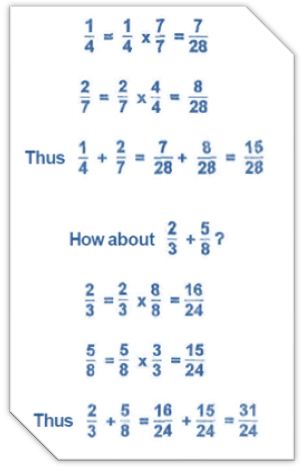Keep in mind that the same pattern of numbers is
repeated in each fraction. Only the starting point varies. You can
calculate the starting point in a flash by multiplying .14 by the numerator In
the case of 2 / 7.2x.14 = .28, use the sequence that starts with 2, that is,
285714. Also with 3/7, since 3 x .14 = .42, use the sequence that begins with
4, namely .428571. Likewise the rest.
I am trying to show you how to calculate very easily
with the aid of MATHS TRICKS.
You will have to calculate fractions higher than
10/11 as you would with any other problem of division, However, keeps your eyes
wide open to find ways to simplify such Problems. For example, you can simplify
fraction 58/16 by dividing both numbers by 2, to reduce it to 29/8, which is
easier to calculate.
If the fraction is an even number, you can simplify
the fraction Reduce it by half, even if the numerator is strange. For example:
Divide the carpets and the denominator in half to
reduce part 7.
Although the seventh sequence shown above does not
provide a 4.5 / 7 decimal point for a single time the calculation begins and
the number you saved appears:
As you can see MATHS FORMULAS, you do not need to solve the whole problem. Once you have
reduced it to divide 3 by 7, it can make a big impression on an audience by
sounding this Long string of numbers almost instantly!
Exercises: Decimalization.
To solve the following problems, do not forget to
use the various 1-digit digits.
Fractions that you already know as decimals. Where
appropriate, simplify the fraction. Before converting it to a decimal.
FRACTIONS
If you can manipulate whole numbers with the
formulas of MATHS TRICKS, then doing arithmetic with fractions is almost so
easy in this MATHS TRICKS chapter,
we review the basic methods of adding, subtracting, Multiply, divide and
simplify fractions. Those who are already familiar with fractions. You
can skip this segment without losing continuity.
Multiplying
fractions
MATHS
TRICKS is also showing you to multiply two fractions, simply
multiply the higher numbers (called numerators), then multiply the numbers
below (called denominators). For example,
What could be easier! Try these exercises before
moving on.
Exercises: Multiplying
Fractions
Dividing
Fractions
Dividing fractions is as easy as multiplying
fractions. There is only one extra he passed. First, turn the second fraction
(this is called reciprocal) and then multiply. For example, the reciprocal of 4/5
is 5/4 Therefore,
Exercises
Now is your turn. Divide these fractions,
SIMPLIFYING
FRACTIONS
Fractions can be considered as small division
problems as we learned MATHS TRICKS
session. For example, 6/3 is the same as 6℅3 = 2 the fraction 1/4 is equal to
1℅4 (which is 0.25 in decimal form).
Now we know that when we multiply any number by 1,
the number stays the same. By 3/5 = 3 / 5x1, but if we replace 1 with 2/2, we
get 3/5 = 3/5 x 1 = 3 / 5x2 / 2 = 6/10 therefore, 3/5 = 6/10 equally But if we
replace 1 with 3/3, we get 3/5 = 3/5 x3 / 3 = 9/15. In other words, if we
multiply the numerator and the denominator by the same number, we obtain a
fraction that is equal to the first fraction.
For another example
It is also true that if
we divide the numerator and the denominator by the same Number, then we get an awesome fraction that is equal to the first.
For example,
This is called
simplifying the fraction.
Exercises
For the following
fractions, can you find an equal fraction whose denominator is 12?
Simplify these
fractions.
Adding
Fractions
This MATHS TRICKS formula shows you: equal
denominators. If the denominators are equal, then we add the numerators and
keep the same denominators.
For example,
Sometimes we can
simplify our response. For example,
Exercises
The most complicated
case: unequal denominators. When the denominators are not the same, then we
replace our fractions with fractions where the denominators are equal.
Exercises
The problems in the
last exercise became easier because the smaller ones denominator divided into
the largest. But what if that is not the case? How could we add something like
1/4 + 2/7? The trick is to create a common denominator by multiplying the top
and bottom of each fraction by the other denominator.
For example,
Exercises
Subtracting
Fractions
Subtracting fractions
works much like adding them together. We illustrate it with example. And
provide exercises for you to do.
Exercises
Well, we have learned how MATH TRICKS works with the aid of MATHEMATICS WORKBOOK FORMULAS so let's move in the next session but before going to next session you have to practice more once you get hot the MATHS TRICKS formulas work then only come in next session.
TAG-division math magician,maths tricks, mathemagics
workbook, mathemagics , maths
games ,math magician, mathematics
tricks, fast
math,magical maths,
mathematics easy tricks,













































